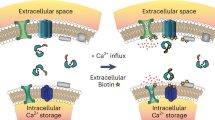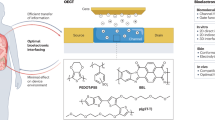Abstract
Connecting neural circuit output to behaviour can be facilitated by the precise chemical manipulation of specific cell populations1,2. Engineered receptors exclusively activated by designer small molecules enable manipulation of specific neural pathways3,4. However, their application to studies of behaviour has thus far been hampered by a trade-off between the low temporal resolution of systemic injection versus the invasiveness of implanted cannulae or infusion pumps2. Here, we developed a remotely controlled chemomagnetic modulation—a nanomaterials-based technique that permits the pharmacological interrogation of targeted neural populations in freely moving subjects. The heat dissipated by magnetic nanoparticles (MNPs) in the presence of alternating magnetic fields (AMFs) triggers small-molecule release from thermally sensitive lipid vesicles with a 20 s latency. Coupled with the chemogenetic activation of engineered receptors, this technique permits the control of specific neurons with temporal and spatial precision. The delivery of chemomagnetic particles to the ventral tegmental area (VTA) allows the remote modulation of motivated behaviour in mice. Furthermore, this chemomagnetic approach activates endogenous circuits by enabling the regulated release of receptor ligands. Applied to an endogenous dopamine receptor D1 (DRD1) agonist in the nucleus accumbens (NAc), a brain area involved in mediating social interactions, chemomagnetic modulation increases sociability in mice. By offering a temporally precise control of specified ligand–receptor interactions in neurons, this approach may facilitate molecular neuroscience studies in behaving organisms.
This is a preview of subscription content, access via your institution
Access options
Access Nature and 54 other Nature Portfolio journals
Get Nature+, our best-value online-access subscription
$29.99 / 30 days
cancel any time
Subscribe to this journal
Receive 12 print issues and online access
$259.00 per year
only $21.58 per issue
Buy this article
- Purchase on Springer Link
- Instant access to full article PDF
Prices may be subject to local taxes which are calculated during checkout




Similar content being viewed by others
Data availability
The data that support the findings of this study are presented within the manuscript and are available from the corresponding author upon request.
Code availability
All the scripts are available from the corresponding author upon request.
Change history
17 December 2019
In the Supplementary Information originally published with this Article, Table S2 was missing. This has now been corrected.
References
Harris-Warrick, R. M. & Marder, E. Modulation of neural networks for behavior. Annu. Rev. Neurosci. 14, 39–57 (1991).
Smith, K. S., Bucci, D. J., Luikart, B. W. & Mahler, S. V. DREADDS: use and application in behavioral neuroscience. Behav. Neurosci. 130, 137 (2016).
Sternson, S. M. & Roth, B. L. Chemogenetic tools to interrogate brain functions. Annu. Rev. Neurosci. 37, 387–407 (2014).
Urban, D. J. & Roth, B. L. DREADDs (designer receptors exclusively activated by designer drugs): chemogenetic tools with therapeutic utility. Annu. Rev. Pharmacol. Toxicol. 55, 399–417 (2015).
Shields, B. C. et al. Deconstructing behavioral neuropharmacology with cellular specificity. Science 356, eaaj2161 (2017).
Misra, A., Ganesh, S., Shahiwala, A. & Shah, S. P. Drug delivery to the central nervous system: a review. J. Pharm. Pharm. Sci. 6, 252–273 (2003).
Dagdeviren, C. et al. Miniaturized neural system for chronic, local intracerebral drug delivery. Sci. Transl. Med. 10, eaan2742 (2018).
Chen, R., Romero, G., Christiansen, M. G., Mohr, A. & Anikeeva, P. Wireless magnetothermal deep brain stimulation. Science 347, 1477–1480 (2015).
Schuerle, S., Dudani, J. S., Christiansen, M. G., Anikeeva, P. & Bhatia, S. N. Magnetically actuated protease sensors for in vivo tumor profiling. Nano Lett. 16, 6303–6310 (2016).
Pankhurst, Q. A., Connolly, J., Jones, S. & Dobson, J. Applications of magnetic nanoparticles in biomedicine. J. Phys. D. 36, R167–R181 (2003).
Huang, H., Delikanli, S., Zeng, H., Ferkey, D. M. & Pralle, A. Remote control of ion channels and neurons through magnetic-field heating of nanoparticles. Nat. Nanotechnol. 5, 602 (2010).
Stanley, S. A. et al. Radio-wave heating of iron oxide nanoparticles can regulate plasma glucose in mice. Science 336, 604–608 (2012).
Munshi, R. et al. Magnetothermal genetic deep brain stimulation of motor behaviors in awake, freely moving mice. eLife 6, e27069 (2017).
Roth, B. L. DREADDs for neuroscientists. Neuron 89, 683–694 (2016).
Yatvin, M. B., Weinstein, J. N., Dennis, W. H. & Blumenthal, R. Design of liposomes for enhanced local release of drugs by hyperthermia. Science 202, 1290–1293 (1978).
Tai, L.-A. et al. Thermosensitive liposomes entrapping iron oxide nanoparticles for controllable drug release. Nanotechnology 20, 135101 (2009).
Christiansen, M. G., Senko, A., Chen, R., Romero, G. & Anikeeva, P. Magnetically multiplexed heating of single domain nanoparticles. Appl. Phys. Lett. 104, 213103 (2014).
Romero, G., Christiansen, M. G., Stocche Barbosa, L., Garcia, F. & Anikeeva, P. Localized excitation of neural activity via rapid magnetothermal drug release. Adv. Funct. Mater. 26, 6471–6478 (2016).
Christiansen, M. G., Howe, C. M., Bono, D. C., Perreault, D. J. & Anikeeva, P. Practical methods for generating alternating magnetic fields for biomedical research. Rev. Sci. Instrum. 88, 084301 (2017).
Chen, T.-W. et al. Ultrasensitive fluorescent proteins for imaging neuronal activity. Nature 499, 295 (2013).
Gunaydin, L. A. et al. Natural neural projection dynamics underlying social behavior. Cell 157, 1535–1551 (2014).
Lammel, S. et al. Input-specific control of reward and aversion in the ventral tegmental area. Nature 491, 212 (2012).
Nestler, E. J. Is there a common molecular pathway for addiction? Nat. Neurosci. 8, 1445–1149 (2005).
Tye, K. M. et al. Dopamine neurons modulate neural encoding and expression of depression-related behaviour. Nature 493, 537–541 (2013).
Morales, M. & Margolis, E. B. Ventral tegmental area: cellular heterogeneity, connectivity and behaviour. Nat. Rev. Neurosci. 18, 73–85 (2017).
Sagar, S., Sharp, F. & Curran, T. Expression of c-fos protein in brain: metabolic mapping at the cellular level. Science 240, 1328–1331 (1988).
Mul, J. D., Zheng, J. & Goodyear, L. J. Validity assessment of 5 day repeated forced-swim stress to model human depression in young-adult C57BL/6J and BALB/cJ mice. eNeuro 3, 0201–0216 (2016).
Rahman, S. & McBride, W. J. D1–D2 dopamine receptor interaction within the nucleus accumbens mediates long-loop negative feedback to the ventral tegmental area (VTA). J. Neurochem. 77, 1248–1255 (2001).
Naahidi, S. et al. Biocompatibility of engineered nanoparticles for drug delivery. J. Control Release 166, 182–194 (2013).
Laurent, S. et al. Magnetic iron oxide nanoparticles: synthesis, stabilization, vectorization, physicochemical characterizations, and biological applications. Chem. Rev. 108, 2064–2110 (2008).
Galal, A. Behavioral Monitoring Tool http://ratmonitoring.sourceforge.net (2001).
Rodriguez, A. et al. ToxTrac: a fast and robust software for tracking organisms. Methods Ecol. Evol. 9, 460–464 (2018).
Rodriguez, A., Zhang, H., Klaminder, J., Brodin, T. & Andersson, M. ToxId: an efficient algorithm to solve occlusions when tracking multiple animals. Sci. Rep. 7, 14774 (2017).
Zhu, X.-N. et al. Ephrin-B3 coordinates timed axon targeting and amygdala spinogenesis for innate fear behaviour. Nat. Commun. 7, 11096 (2016).
Park, S. et al. One-step optogenetics with multifunctional flexible polymer fibers. Nat. Neurosci. 20, 612–619 (2017).
Acknowledgements
We thank B. Roth, D. Kim and F. Zhang for the generous gifts of the plasmids and cell lines, Z. He, Y. Lin, the Viral Core of Boston Children’s Hospital and the University of Pennsylvania Vector Core for packaging of the AAVs and for the support and advice on virus packaging, A. Galal for the scripts used in the analysis of behaviours and S. Lall and A. Jasanoff for their thoughtful comments on our manuscript. This work was funded in part by DARPA ElectRx Program under D. Weber (HR0011-15-C-0155), the Bose Research Grant and the National Institutes of Health BRAIN Initiative (1R01MH111872). This work made use of the Massachusetts Institute of Technology (MIT) MRSEC Shared Experimental Facilities under award no. DMR-14-19807. S.R. and R.C. are supported by a grant from the Simons Foundation to the Simons Center for the Social Brain at MIT. Methods of analysis and additional data are included in the Supplementary Information.
Author information
Authors and Affiliations
Contributions
S.R., R.C. and P.A. designed all the experiments and performed all the analyses. M.G.C. and A.W.S. designed and constructed the magnetic field coils. S.R., R.D. and J.M. developed the magnetoliposome preparation methods. P.-H.C. constructed the DNA plasmids. S.R. and J.X. packaged the viral vectors. S.R., A.A.L., C.H.S. and Y.Z. conducted behavioural experiments and analyses. S.R., A.A.L. and C.H.S. conducted the immunohistochemistry analyses. G.V. and A.A.L. wrote the scripts for the automatic classifier used for the FST assays. C.H.S. wrote the scripts for calcium imaging visualization and social behaviour analyses. G.F. advised on social preference assays and facilitated the analysis of behavioural data. S.R. and S.P. conducted the statistical analysis. All the co-authors contributed to the writing of the manuscript.
Corresponding author
Ethics declarations
Competing interests
The authors declare no competing interests.
Additional information
Peer review information Nature Nanotechnology thanks Joao Carvalho-de-Souza, Patricia Janak and Shan Wang for their contribution to the peer review of this work
Publisher’s note Springer Nature remains neutral with regard to jurisdictional claims in published maps and institutional affiliations.
Supplementary information
Supplementary Information
Supplementary Figs. 1–21, Supplementary Table 1 and Supplementary refs. 1–11.
Rights and permissions
About this article
Cite this article
Rao, S., Chen, R., LaRocca, A.A. et al. Remotely controlled chemomagnetic modulation of targeted neural circuits. Nat. Nanotechnol. 14, 967–973 (2019). https://doi.org/10.1038/s41565-019-0521-z
Received:
Accepted:
Published:
Issue Date:
DOI: https://doi.org/10.1038/s41565-019-0521-z
This article is cited by
-
Self-rectifying magnetoelectric metamaterials for remote neural stimulation and motor function restoration
Nature Materials (2024)
-
Control of polymers’ amorphous-crystalline transition enables miniaturization and multifunctional integration for hydrogel bioelectronics
Nature Communications (2024)
-
Magnetic control of self-assembly and disassembly in organic materials
Nature Communications (2023)
-
Optical control of neuronal activities with photoswitchable nanovesicles
Nano Research (2023)
-
Recent advances of superparamagnetic iron oxide nanoparticles and its applications in neuroscience under external magnetic field
Applied Nanoscience (2023)



